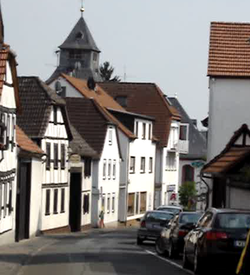
Breckenheim
Encyclopedia
Breckenheim, Germany is one of Wiesbaden's
eastern suburbs, and was incorporated into the city of Wiesbaden on 1 January 1977. It has a population of about 3,600.
 The first known mention of Breckenheim is from a charter dated 1 May 950 in which King Otto I donates land in the Königssondergau
The first known mention of Breckenheim is from a charter dated 1 May 950 in which King Otto I donates land in the Königssondergau
in Breckenheim, nearby Wallau
and Nordenstadt
to the count Gerung. The document reads in Latin: "in villa Wanaloha et Brechenheim in pago Kunigessundera vocato in comitatu prefati Gerung comitis.
In the Middle Ages, the village and others surrounding belonged to the Lords of Eppstein
from 1137. On 15 May, 1251 the archbishop of Mainz donated several properties in Breckenheim and Erbenheim
to the College
of Mainz Cathedral
. Of the extant buildings in Breckenheim, only the church tower, which was first mentioned in 1280, remains from this time. Breckenheim and other villages in the area were sold in 1492 to William III
, the landgrave
of Upper Hesse
, and was passed to Hesse-Marburg
in 1567, then in 1604 to Hesse-Kassel
(or Hesse-Cassel), then to Hesse-Darmstadt
in 1624. The church at the center of the old village was completed in 1724, replacing the original which was destroyed along with most of Breckenheim in the Thirty Years' War
. In 1803 the village was passed to Nassau
and in 1866 was annexed by Prussia
.
Wiesbaden
Wiesbaden is a city in southwest Germany and the capital of the federal state of Hesse. It has about 275,400 inhabitants, plus approximately 10,000 United States citizens...
eastern suburbs, and was incorporated into the city of Wiesbaden on 1 January 1977. It has a population of about 3,600.
History

Königssondergau
The Königssondergau was a Frankish gau which existed in the area north of the confluence of the Rhine and Main rivers in Germany, from Frankish times until the end of the 12th century. Often mistakenly equated with the Rheingau, the Gau was based around the former Roman administrative district...
in Breckenheim, nearby Wallau
Wallau
right|thumb|The Coat of Arms of WallauWallau im Taunus is a quarter of Hofheim in Main-Taunus-Kreis in Hesse, Germany, and has a population of 4,650....
and Nordenstadt
Nordenstadt
Nordenstadt is one of Wiesbaden's eastern suburbs, and was incorporated into the city of Wiesbaden on 1 January 1977. Its population is approximately 8,500 and it hosted the first corporate headquarter of Daewoo Germany in the early 1990s....
to the count Gerung. The document reads in Latin: "in villa Wanaloha et Brechenheim in pago Kunigessundera vocato in comitatu prefati Gerung comitis.
In the Middle Ages, the village and others surrounding belonged to the Lords of Eppstein
Lords of Eppstein
The Lords of Eppstein were a family of German nobility in the Middle Ages. From the 12th century they ruled extensive territories in the Rhine Main area from their castle in Eppstein, northwest of Frankfurt, Germany.-History:...
from 1137. On 15 May, 1251 the archbishop of Mainz donated several properties in Breckenheim and Erbenheim
Erbenheim
Erbenheim is a borough of Wiesbaden, capital of the federal state of Hesse, Germany. It was incorporated into Wiesbaden on April 10, 1928. The population is around 9,000....
to the College
College
A college is an educational institution or a constituent part of an educational institution. Usage varies in English-speaking nations...
of Mainz Cathedral
Mainz Cathedral
Mainz Cathedral or St. Martin's Cathedral is located near the historical center and pedestrianized market square of the city of Mainz, Germany...
. Of the extant buildings in Breckenheim, only the church tower, which was first mentioned in 1280, remains from this time. Breckenheim and other villages in the area were sold in 1492 to William III
William III, Landgrave of Hesse
William III "the Younger", Landgrave of Hesse ruled on the part of the county known as Upper Hesse, with residence in Marburg....
, the landgrave
Landgrave
Landgrave was a title used in the Holy Roman Empire and later on by its former territories. The title refers to a count who had feudal duty directly to the Holy Roman Emperor...
of Upper Hesse
Landgraviate of Hesse
The Landgraviate of Hesse was a Landgraviate of the Holy Roman Empire. It existed as a unity from 1264 to 1567, when it was divided between the sons of Philip I, Landgrave of Hesse.-History:...
, and was passed to Hesse-Marburg
Hesse-Marburg
The Landgraviate of Hesse-Marburg was a German landgraviate, and independent principality, within the Holy Roman Empire, that existed between 1485 and 1500, and between 1567 and 1604/1650....
in 1567, then in 1604 to Hesse-Kassel
Hesse-Kassel
The Landgraviate of Hesse-Kassel or Hesse-Cassel was a state in the Holy Roman Empire under Imperial immediacy that came into existence when the Landgraviate of Hesse was divided in 1567 upon the death of Philip I, Landgrave of Hesse. His eldest son William IV inherited the northern half and the...
(or Hesse-Cassel), then to Hesse-Darmstadt
Landgraviate of Hesse-Darmstadt
The Landgraviate of Hesse-Darmstadt was a member state of the Holy Roman Empire. It was formed in 1567 following the division of the Landgraviate of Hesse between the four sons of Philip I, the last Landgrave of Hesse....
in 1624. The church at the center of the old village was completed in 1724, replacing the original which was destroyed along with most of Breckenheim in the Thirty Years' War
Thirty Years' War
The Thirty Years' War was fought primarily in what is now Germany, and at various points involved most countries in Europe. It was one of the most destructive conflicts in European history....
. In 1803 the village was passed to Nassau
Nassau (state)
Nassau was a German state within the Holy Roman Empire and later in the German Confederation. Its ruling dynasty, now extinct in male line, was the House of Nassau.-Origins:...
and in 1866 was annexed by Prussia
Prussia
Prussia was a German kingdom and historic state originating out of the Duchy of Prussia and the Margraviate of Brandenburg. For centuries, the House of Hohenzollern ruled Prussia, successfully expanding its size by way of an unusually well-organized and effective army. Prussia shaped the history...
.

